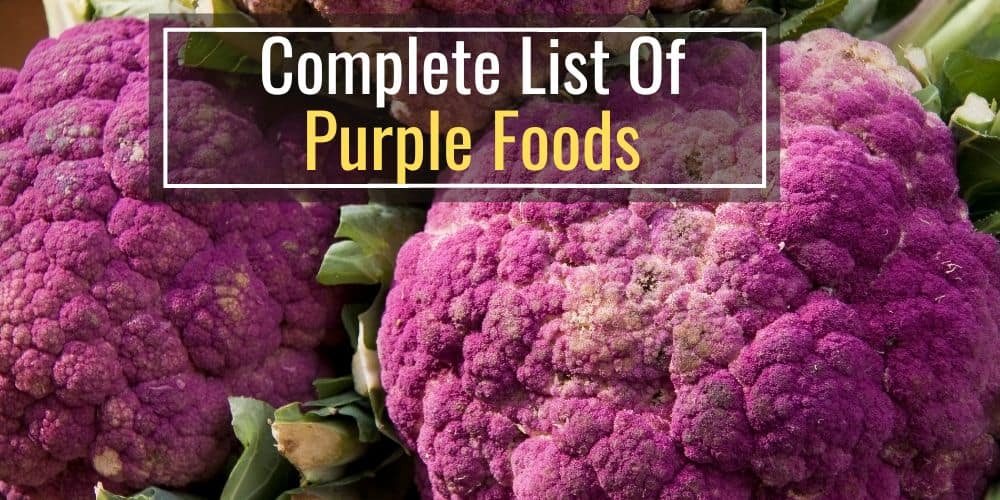Purple foods can add a lot of bright colors to your diet.
Not to mention, purple foods generally have many health benefits including being high in antioxidants.
From purple sweet potatoes to beet juice, there are many different purple foods that you can eat.
So, if you want to add more purple-colored foods to your diet then look no further! We’ve compiled the list of purple foods listed in alphabetical order.
Here is a list of all the different food-colored lists with pictures if you’re looking for other colored foods:
1. Acai Berries
The first food on our list is Acai Berries.
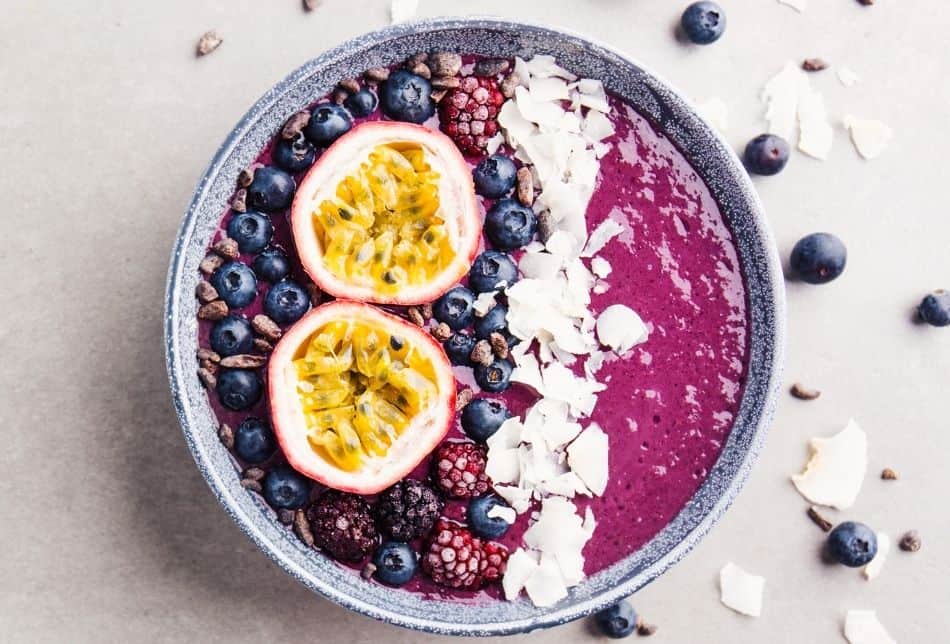
This deep purple fruit is found in the rainforests of South America. It looks like a grape and has a liquid-like texture, which offers several health benefits.
Acai berries possess essential fatty acids such as omega-3, omega-6, and monounsaturated oleic acid. No wonder it is dubbed a superfood.
Fact: Acai berries have more antioxidants than blueberries, cranberries, raspberries, blueberries, and strawberries.
2. Baby Purple Artichokes
The second purple food on our list is baby purple Artichokes.
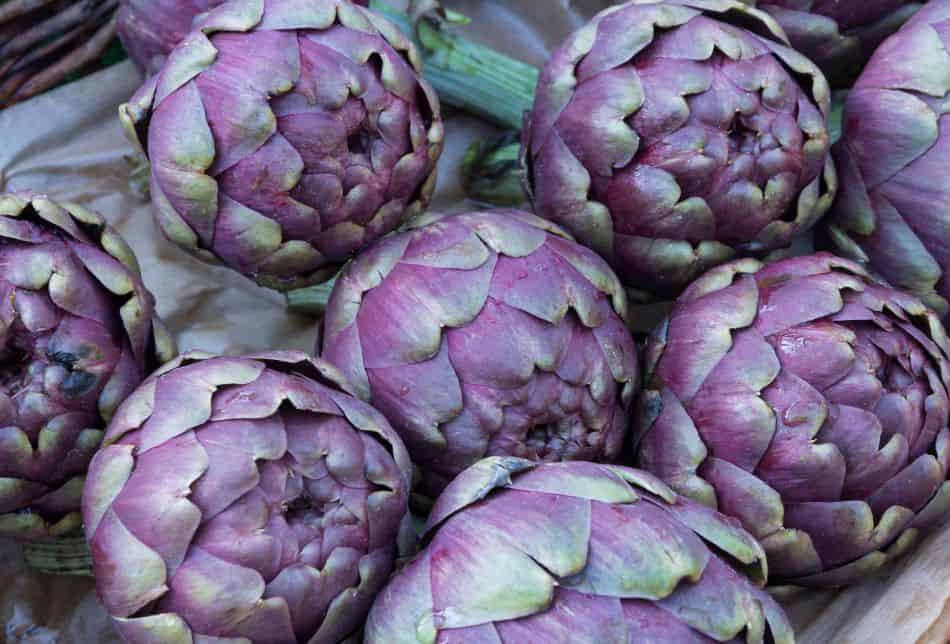
These Mediterranean natives have a floret that resembles the famous flower tulip.
They also come in deep purple colors, and their taste is slightly stronger than their green counterparts.
Baby purple artichokes can be eaten raw, grilled, braised, or roasted.
These make a great addition to salads, pasta dishes, dips, and sauces.
3. Beetroot
Beetroot has a long, colorful history dating back to the 16th century and was first cultivated in Germany or Italy.

This root vegetable has a deep purple color and is a good source of fiber, vitamin C and B9, and minerals such as iron, manganese, and potassium.
You can eat beetroot raw, roasted, baked, or boiled.
It also combines well with some ingredients to make salads, soups, stews, and gratins. You can even make chips or fries with it.
Fact: The ancient Greeks used beetroot for treating painful disorders such as headaches and toothaches.
4. Beet Greens
Beet greens are believed to be from the Mediterranean coast.
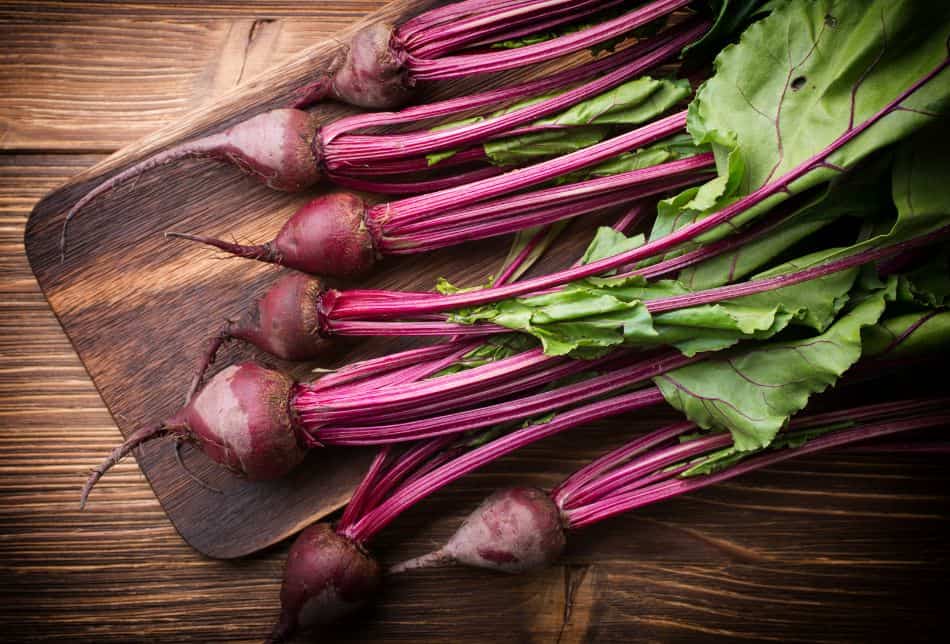
These greens are the foliage that grows over the top of the beet fruit.
They are crimson-red to purple greens, highly nutritious, and contain vitamins A, C, and K. They also contain minerals like iron, calcium, fiber, and magnesium.
Beet greens can be consumed raw in salads or cooked like other leafy greens. They have a slightly sweet and earthy flavor that goes well with other strong-flavored ingredients.
5. Beet Juice
The next food on our list is a byproduct of the beet fruit—beet juice.
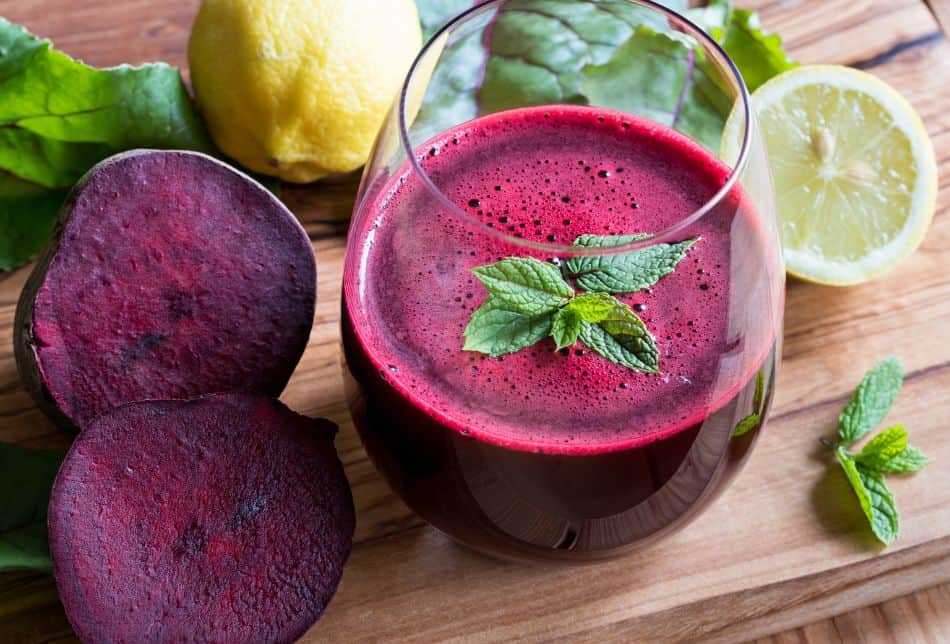
Beet juice is a great way to get nutrients from beets without eating them whole.
Beet juice is high in vitamins and minerals, as well as antioxidants.
So, if you’re looking for a health boost, try adding some beet juice-rich betalain to your diet. You can find it fresh or bottled at most grocery stores.
6. Cherries (Chelan Cherry)
Cherries are stone fruit native to eastern Europe and western Asia.
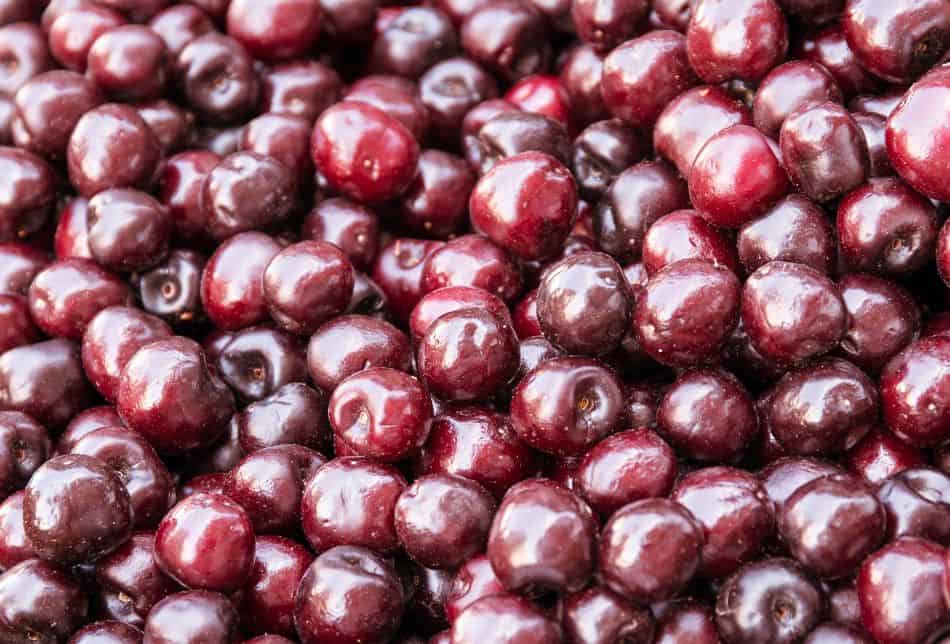
The bright red or purple skin has sweet juicy flesh full of vitamins C, A, and polyphenols (a type of antioxidant). It also contains fiber, potassium, plus iron.
You can enjoy purple cherries raw or in many dishes.
They make great additions to pies, tarts, jams, or jellies.
Fun fact: Purple cherries are hardy types and thus have a long shelf life.
7. Concord Grapes
Grapes come in many different colors, including purple.
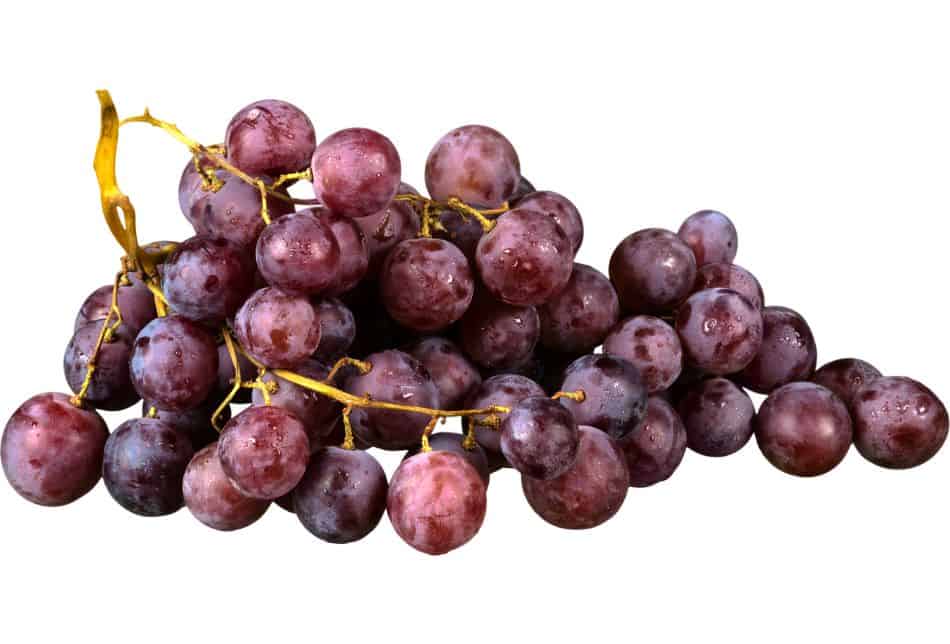
Concord grapes are a type of purple fruit that comes from the Eastern region of North America. These juicy, sweet treats have been known to make great juice and jelly.
This low-calorie option packs a punch with vitamins C and K and iron and potassium manganese in each bite.
You can try concord grapes in a fruit salad or as a healthy snack. You can also make wine with them.
Fact: Grapes were one of the first fruits to be cultivated by humans.
8. Concord Grape Juice
Concord grape juice is a type of grape juice that is made from concord grapes.
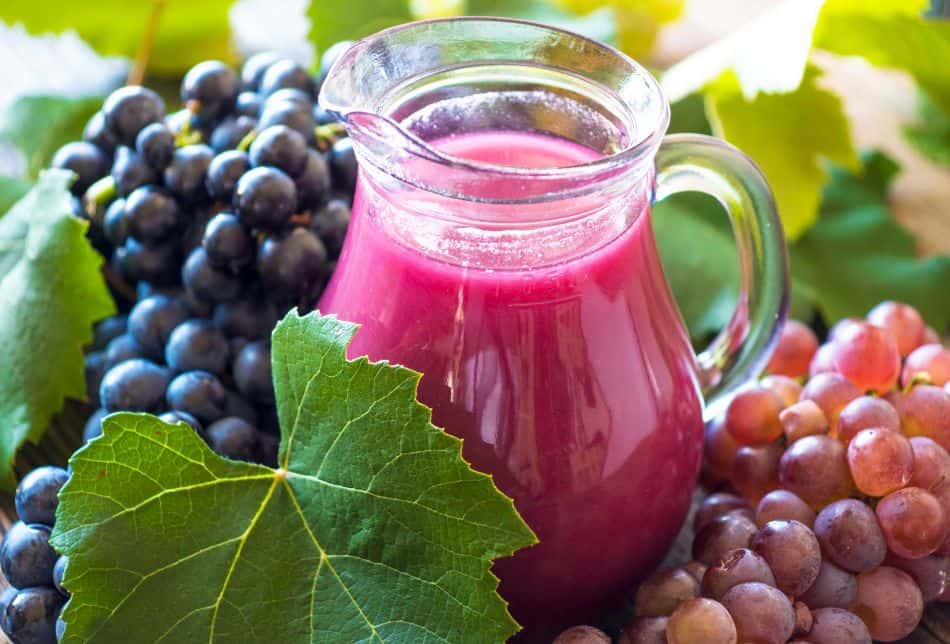
It has a deep blue-purple color and a sweet taste.
It is an enriching juice rich in vitamins C and K and is full of manganese, potassium, and iron. You can take Concord grape juice alone or use it in cocktails and mocktails.
Fact: Concord grapes juice helps in controlling blood sugar levels.
9. Eggplant
The next food—eggplant, has a dark purple hue. Eggplants are natives of Assam in the Indian subcontinent and the Burma region.
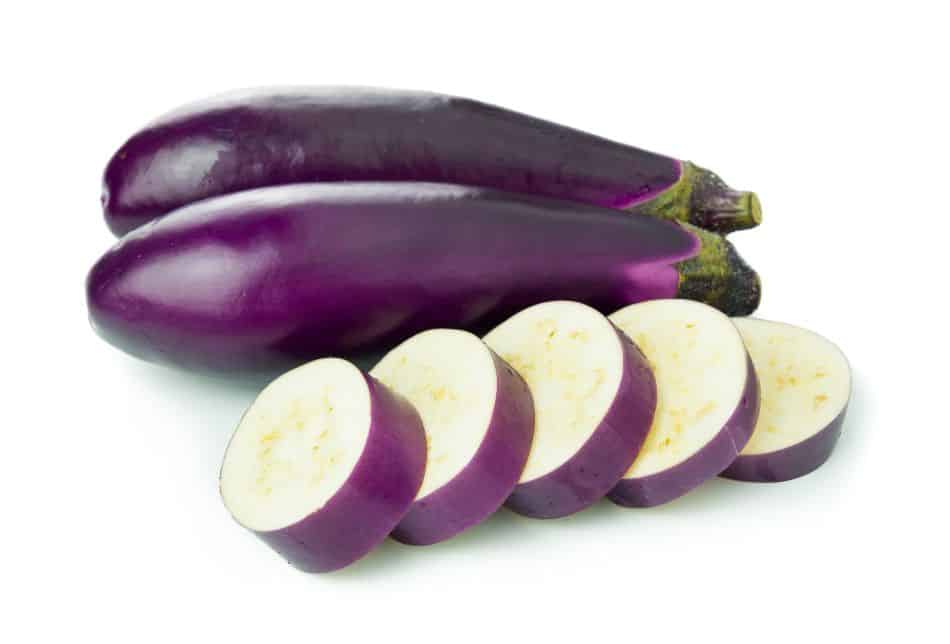
It is a nightshade vegetable found in many colors, including white and green. The most preferred type of eggplant is the purple variety.
Eggplants are an excellent source of fiber, vitamins, and minerals.
They also contain phytonutrients which have been shown to benefit your heart.
10. Elderberries
The elderberry is a small and juicy berry that can be found natively in Northern China and Northern Europe.
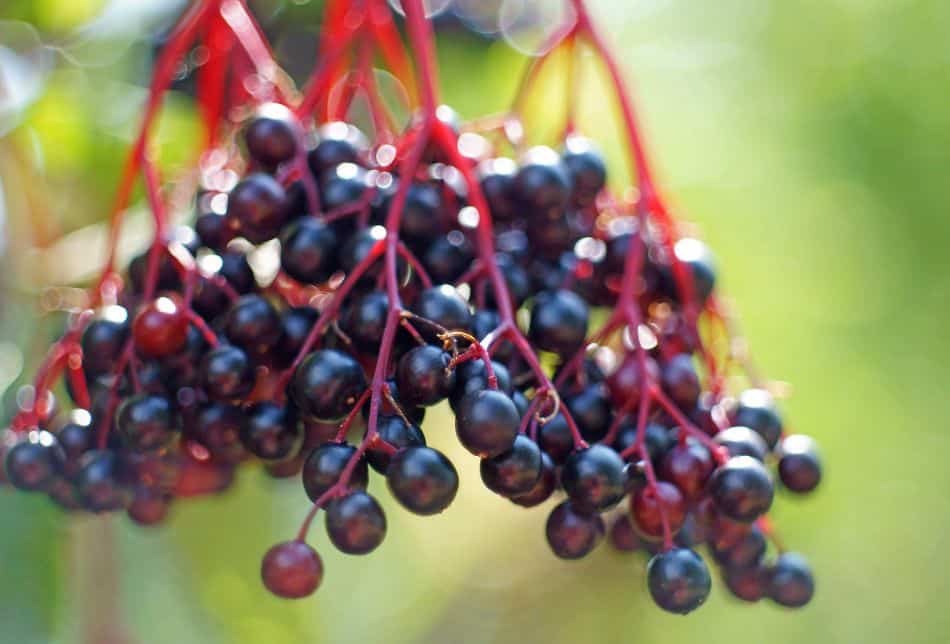
It has a deep purple color with a slightly sweet and tart flavor. People often use this fruit to make jams, jellies, chutneys, juices, or pies.
The elderberry is an excellent source of vitamins C.
It also contains phosphorus, calcium, and potassium, in addition to iron.
Elderberries and elderflowers can be eaten raw or cooked. They taste great in pies, jams, muffins, and beverages like wine that is made from them.
11. Figs
Purple figs belong to the mulberry family. It is a native of Western Asia.
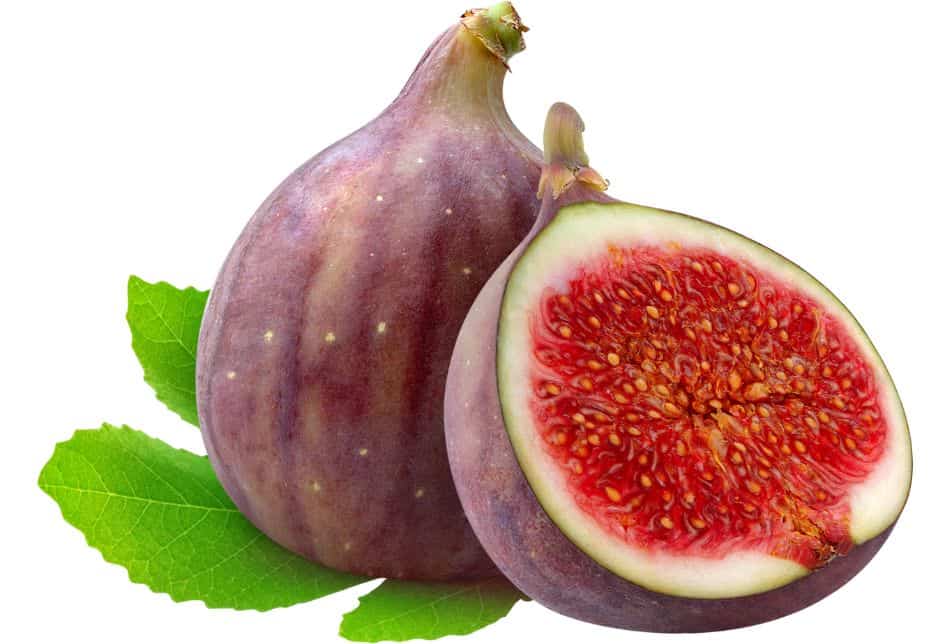
The young fruit is green but changes its hue on maturity and becomes brown to dark purple with red to purple flesh. Purple figs are the sweetest of all varieties.
Fig leaves are often used to wrap other foods like meat or vegetables.
The fig’s slightly bitter taste makes it an excellent addition to any dish that needs some extra flavor, and its vitamins and minerals will keep you healthy.
Fact: Fig seeds are also edible.
12. Forbidden Rice
The next food on our list, Forbidden rice, turns purple when cooked.
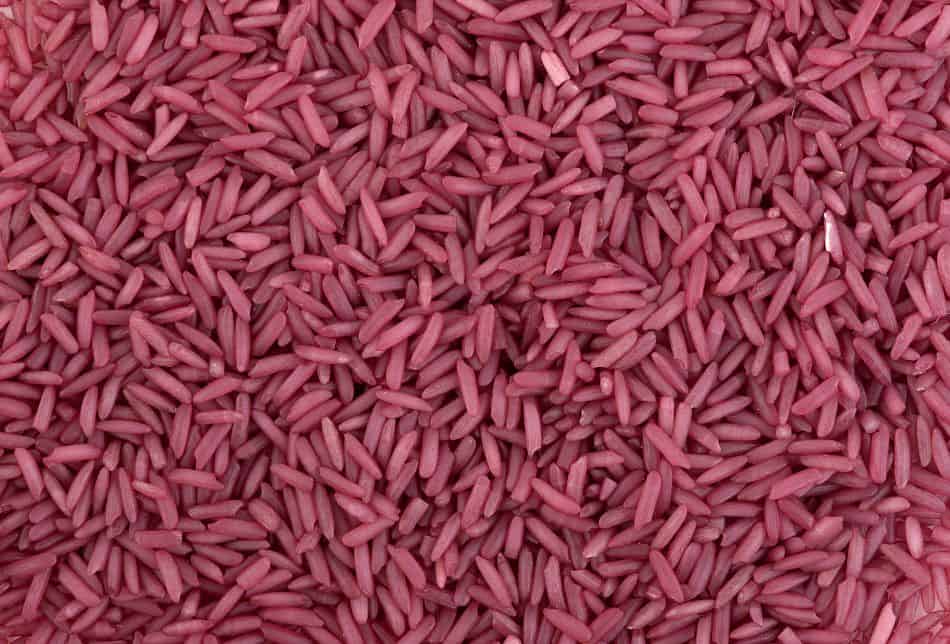
This black rice was once reserved for Chinese emperors and was forbidden to be eaten by the general public. It is now available for everyone to enjoy.
Forbidden rice has a nutty flavor and a chewy texture. It provides you with vitamins A, C, and B6. It also contains copper, manganese, potassium, and fiber.
Forbidden rice has a nutty flavor and a chewy texture. It is a good source of protein, fiber, and iron. It is also high in antioxidants. Try it in a rice pudding or as a replacement for plain white rice.
13. Kale
Kale plants are varieties of cabbage with green or purple leaves. The central leaves of a kale plant do not form a head, unlike a headed cabbage.

Kale is mildly sweet than other types of kale. Purple kale is a good source of vitamins B6, C, and K. It is also rich in calcium, copper, and manganese.
The nutrient-dense food can be eaten raw or cooked. Finally, you can add nutrients with flavor in salads, soups, and stir fry dishes with kale.
Fact: Purple kale is sometimes called “Redbor” kale.
14. Lavender
Lavender is a beautiful flowering plant that belongs to the mint family. It is available in nature in many different colors, including purple.
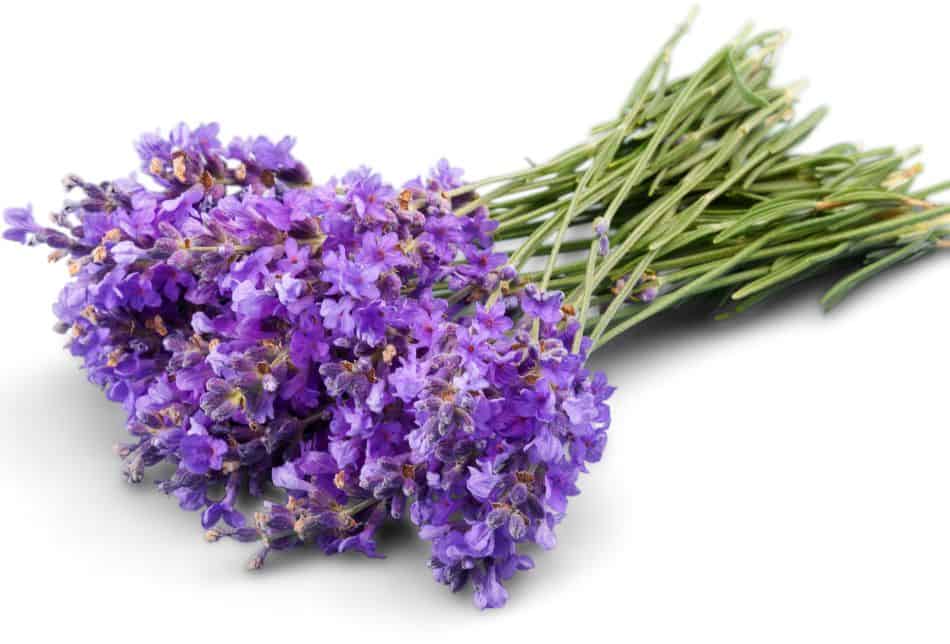
The perennial shrub is a native of the Old World, the Mediterranean region, and the countries east of India.
Purple lavender has a sweet and floral flavor. It can be used to make tea, extract essential oils, or add flavor to foods.
15. Mangosteen
The mangosteen is a tropical fruit that is native to Southeast Asia. The skin has light greenish-yellow tones and scattered pink spots to dark purple.
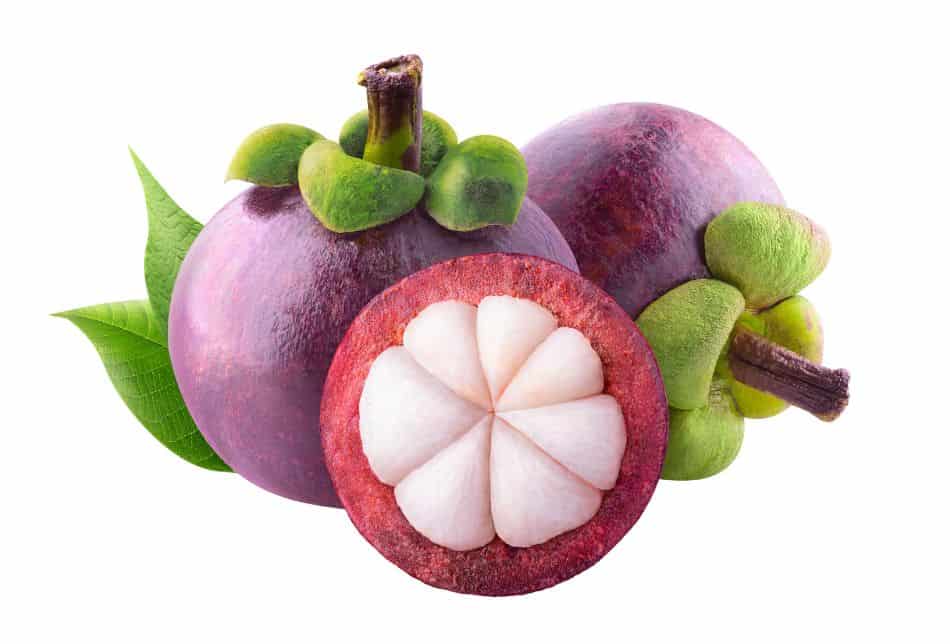
It is a delicious mix of peach, lychee, pineapple, and strawberry. The fruit has a sweet-tangy taste and is often used in desserts or as a garnish.
You can eat the fruit whole, in salad, or make a smoothie with this delicious and healthy ingredient.
You could also use it to make jam and jelly ice cream. It is a good source of vitamins A, C, and B6. It also contains copper, manganese, potassium, and fiber.
Fact: The mangosteen is the national fruit of Thailand.
16. Passion Fruit
Passion fruit is a long and elongated fruit from the tropical region of South America.
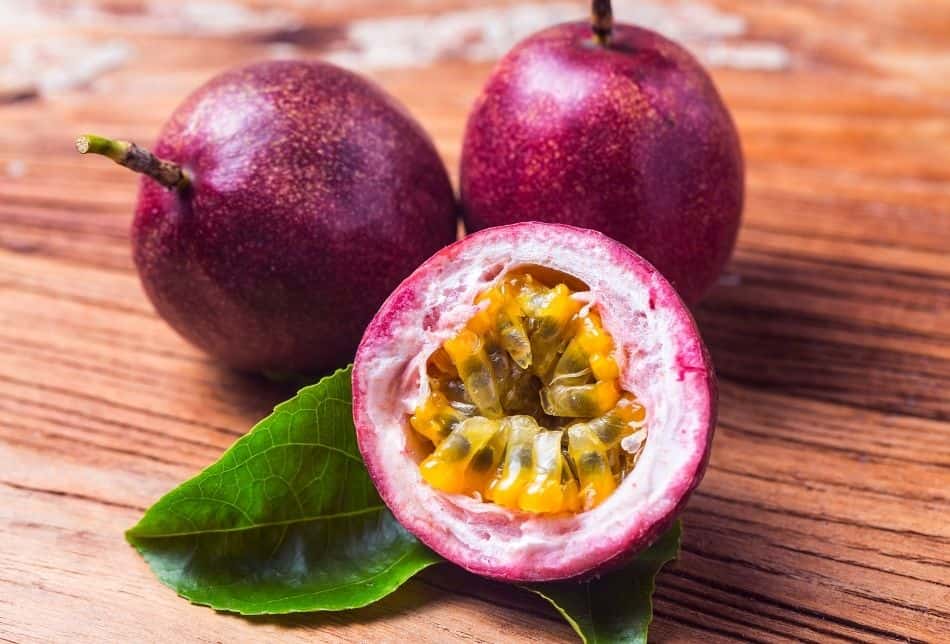
The exterior contains deep purple skin, while its interior is bright yellow with black seeds. It also provides you with reasonable amounts of vitamin A and C, flavonoids, and fiber.
Passion fruit can be added to a variety of dishes. You could eat it raw, juice, or make jam and jelly with this delicious crop.
Fact: Passion fruit is the national fruit of Paraguay.
17. Plums (Damsons Plum)
The damson or “damascene” is a subspecies of the plum tree with an Asiatic origin. It was first grown in China.
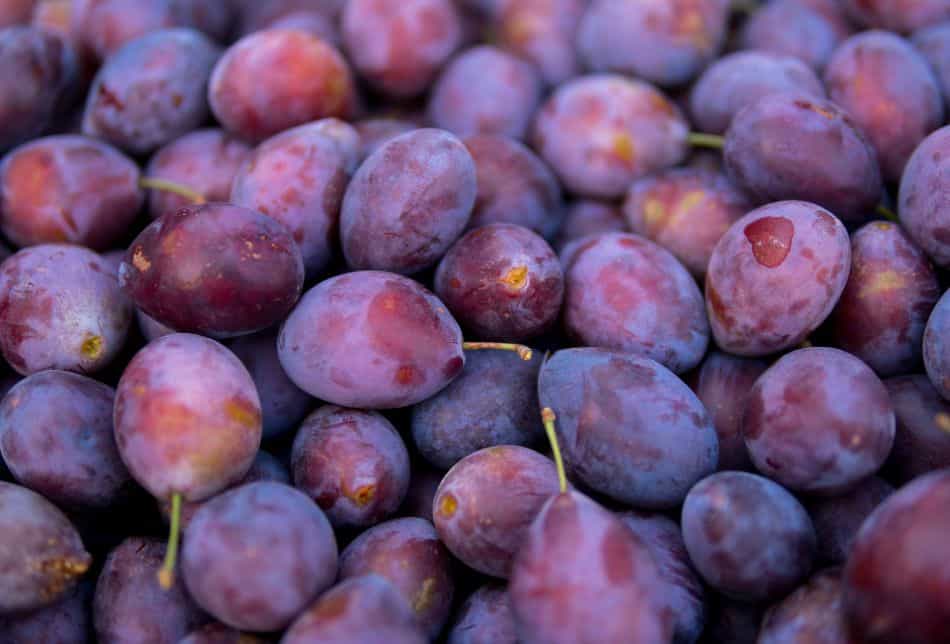
The dark purple fruits of this plant are sour with a sweet-sour pulp inside. It’s also rich in vitamins C and K and contains fiber, copper, and manganese for good measure.
You may enjoy them raw or cooked, either alone, as an appetizer, or on top of your favorite dish to add extra flavor.
They make great additions for pies and tarts or making plum wine.
Fact: Plums are a member of the rose family.
18. Pluots (Dapple Dandy Pluot)
The purple pluot is a cross between an apricot and a plum. It has smooth, soft skin with sweet juicy flesh that’s great for eating on its own or in pies.
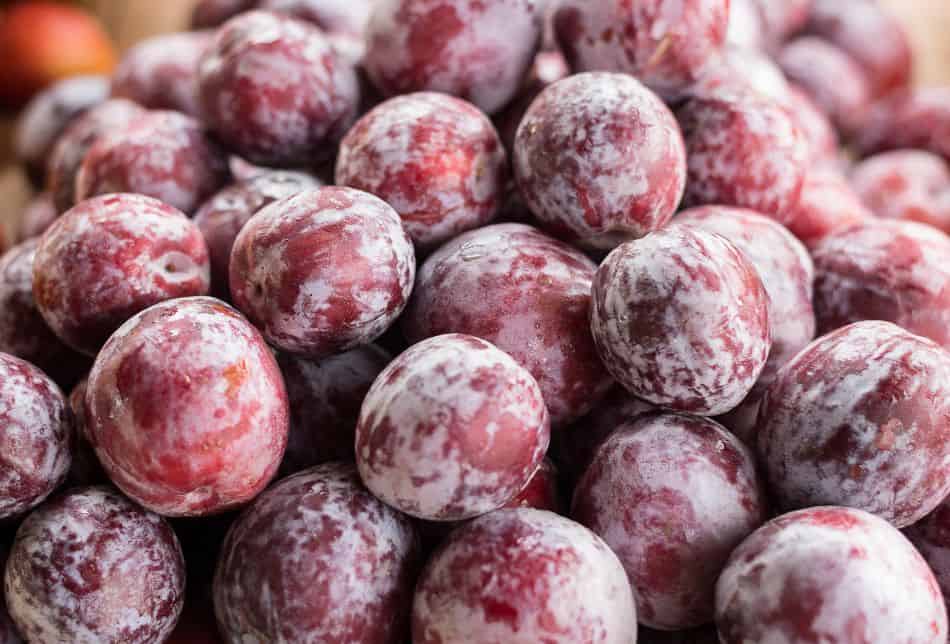
The deep purple color of this fruit makes it perfect for adding some extra flavor when making your favorite dishes like jams, jellies, and smoothies.
Pluots are an excellent source of vitamins A and C, fiber, and potassium.
Fact: In 1989, a stone fruit called the “Pluot” was developed by Floyd Zaiger of Zaiger Genetics.
19. Pomegranates
The pomegranate is a fruit that’s native to Iran and its neighboring countries.
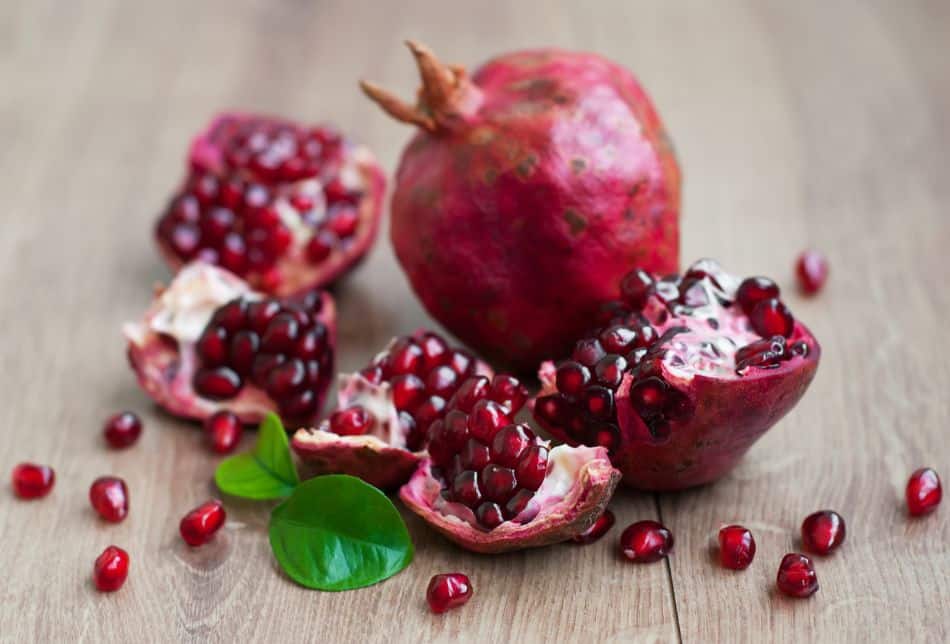
The deep red-purple color of this delicious treat makes it perfect for celebrations or everyday life. You can enjoy their sweet-tart flavor in juice, jelly sweets like syrup.
Pomegranates are a good source of vitamins C and K. They also contain iron, potassium, and zinc.
Fun fact: Pomegranates have been cultivated for over 4,000 years.
20. Prunes
Prunes are a type of dried fruit with an oval shape.
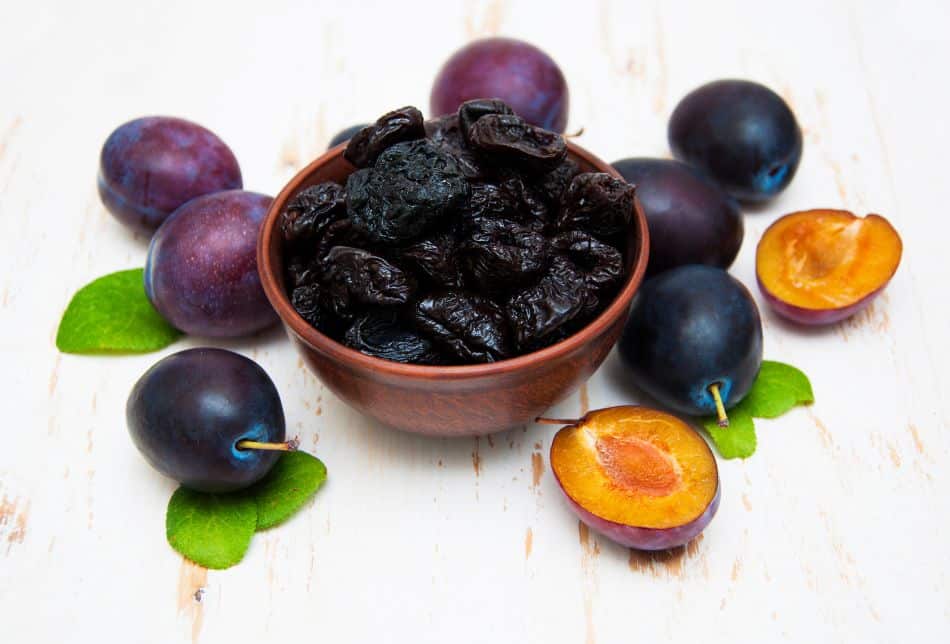
The deep purple color comes from the skin, which wrinkles up when it becomes dry; inside, there is sweet with just enough tartness to make them delectable.
Prunes are a fantastic resource of fiber, vitamins B and K. They also contain copper, magnesium, and manganese.
Prunes can be consumed alone, as a snack, or used in recipes. They make a great addition to oatmeal, yogurt, or baked goods. You can also use them to make pudding, cake, salad, or pie.
Fact: Prunes are sometimes called “dried plums”.
21. Purple Asparagus
Purple asparagus is from the lily family. It is native to the Albenga region of Italy.
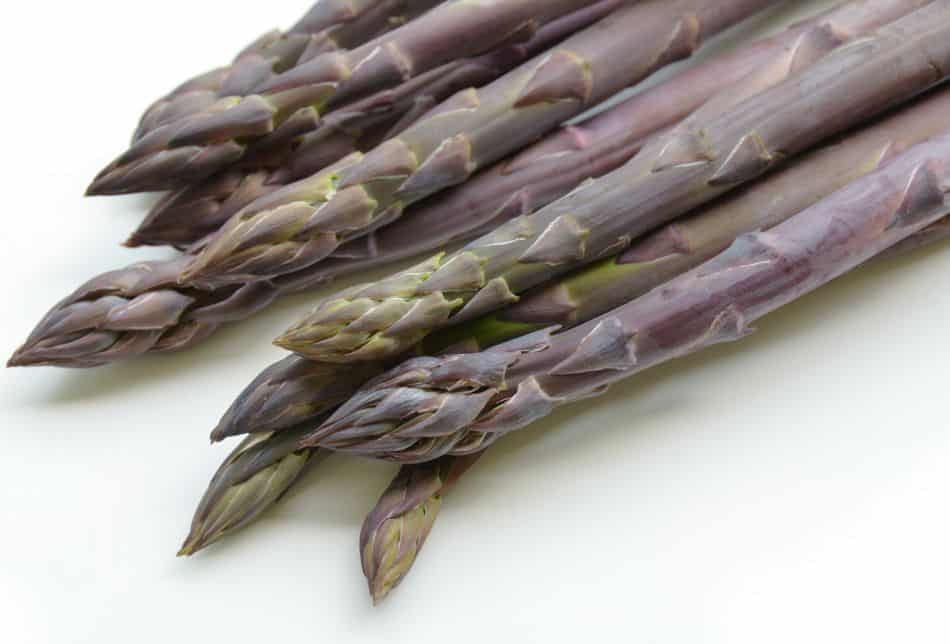
The asparagus has a deep purple color and white flesh rich in vitamins C and B6, along with some minerals like manganese, zinc, and selenium.
Depending on your preference, you can enjoy its sweet-nutty flavor, raw or cooked. They are great as an accompaniment to salads, soups, and smoothies.
Fact: Asparagus is one of the oldest vegetables. It has been cultivated for over 2500 years.
22. Purple Barley
The barley grain is an heirloom variety, originally from Tibet. It has a dark purple hue and provides high levels of protein with a nutty flavor that’s chewy in texture.
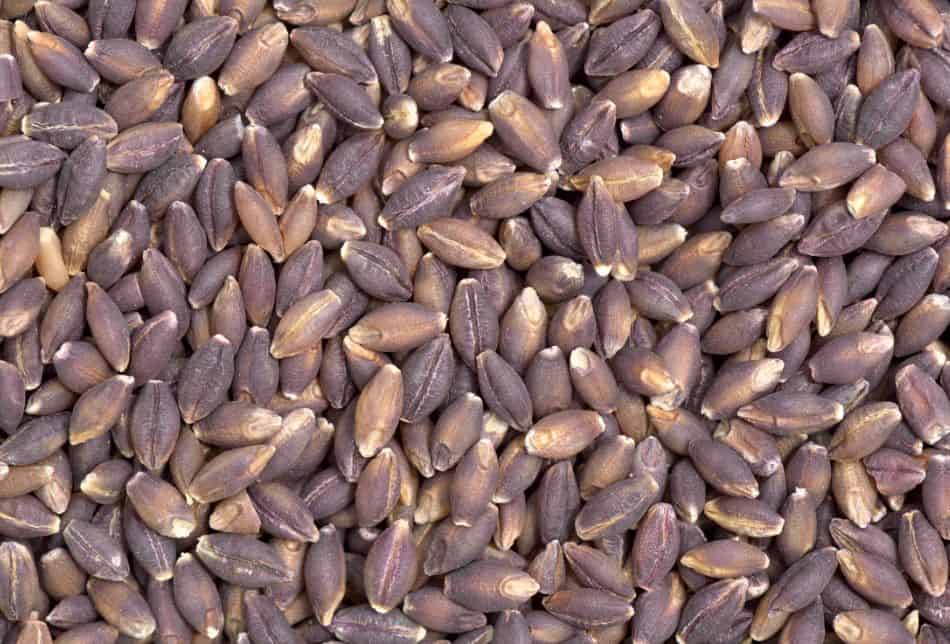
Purple barley is a good source of fiber, vitamins B1 and B3, and minerals such as copper and manganese.
You can eat it raw or cook the grain until tender and use it as an ingredient for soups or stews. You can also use it to make flour or bread.
Fact: It has more anthocyanin content than blueberries.
23. Purple Basil
Basil is a mint family member and native to India and other tropical Asian countries.
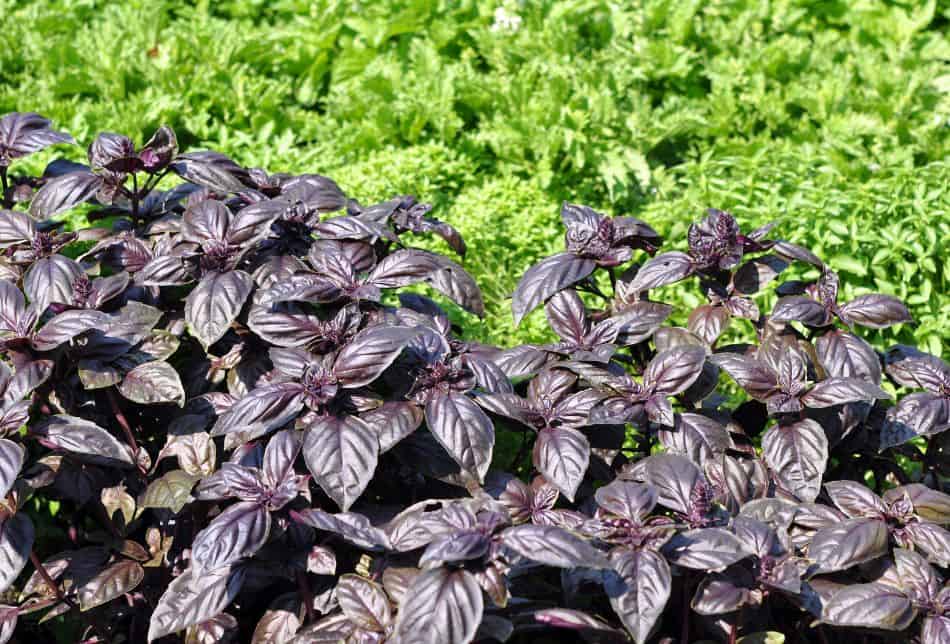
The purple basil has deep purple leaves; these leaves are smaller than their greener counterparts. It has a sweet clove flavor and is a good source of vitamins A, E, C, and K.
Basil also contains calcium, manganese, and potassium.
You can use purple basil to make your cooking more flavorful and exciting. Depending on what you’re making, you can add it as an ingredient for sauces, stews, or salad dressings.
Fact: The word “basil” is taken from the Greek word for “royal.”
24. Purple Belgian Endive
Endive is a type of leafy green related to the chicory family. The scoop-like shape is white with reddish-purple tips and can be found natively in Netherlands or France.
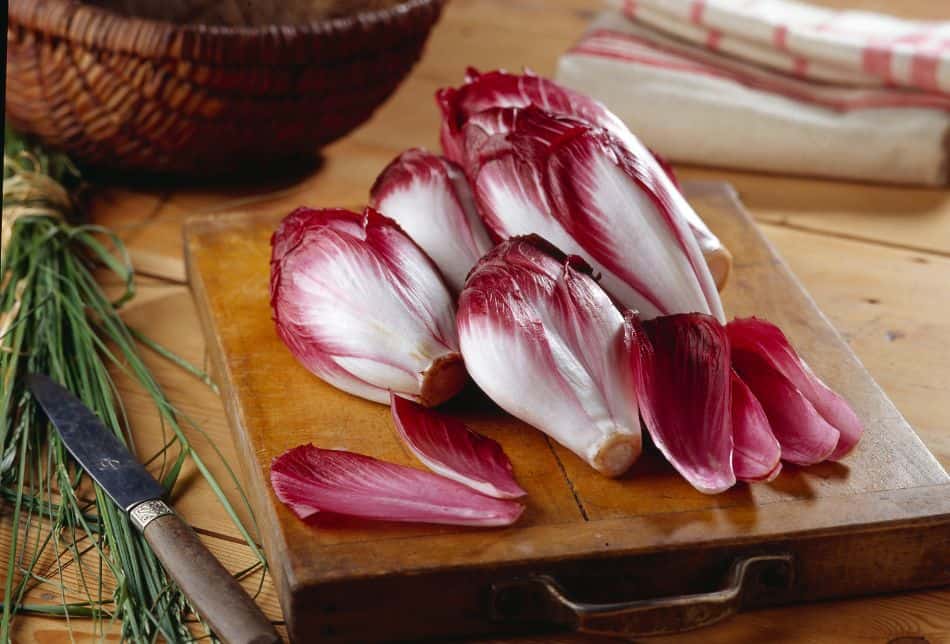
This purple/white vegetable has a bitter taste and crunchy texture. It also contains vitamins A & C, fiber, and folic acid to keep you going throughout the day.
You can eat purple Belgian endive raw or cooked. They’re great as an ingredient in salads, soup stock, and stir-fries.
Fact: Endive belongs to the daisy family. The word “endive” comes from the Latin word for “bitter.”
25. Purple Bell Pepper
Purple pepper is a type of chili pepper that is native to South and Central America. They are edible fruits of the upright plant.
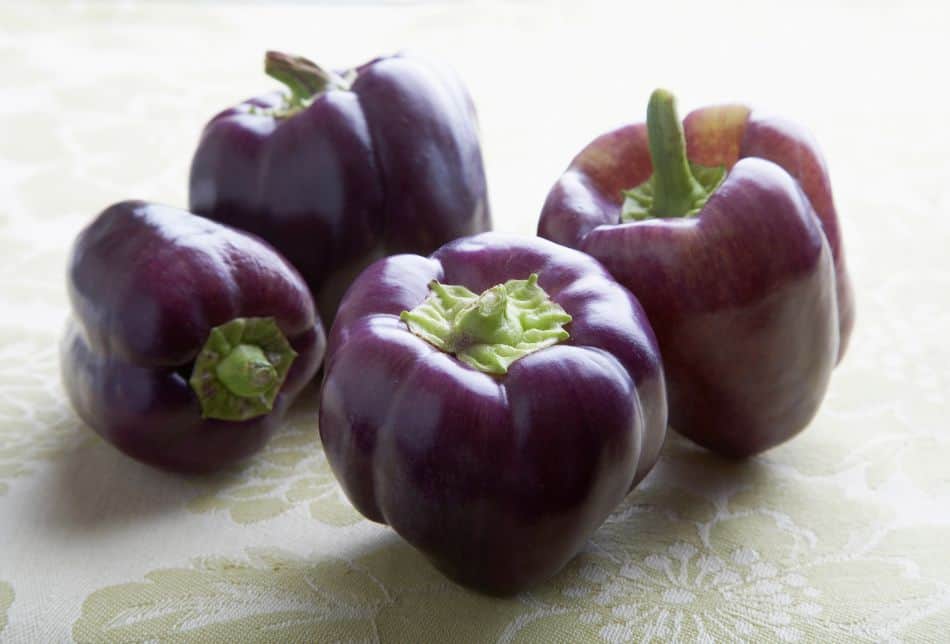
The pepper’s color changes with age. At first, it is green and slowly turns white before developing purple streaks that turn completely purple on the vine.
They’re not as spicy or bitter as other peppers, so they make a great addition to sauces, relishes, and marinades. These sweet red fruits pack an impressive amount of Vitamin C and B6.
Fact: The purple pepper is also known as the “Peruvian pepper.”
26. Purple Broccoli
Broccoli is a leafy green from the same family as cabbages. Broccolis are native to Asia Minor and other Mediterranean countries.
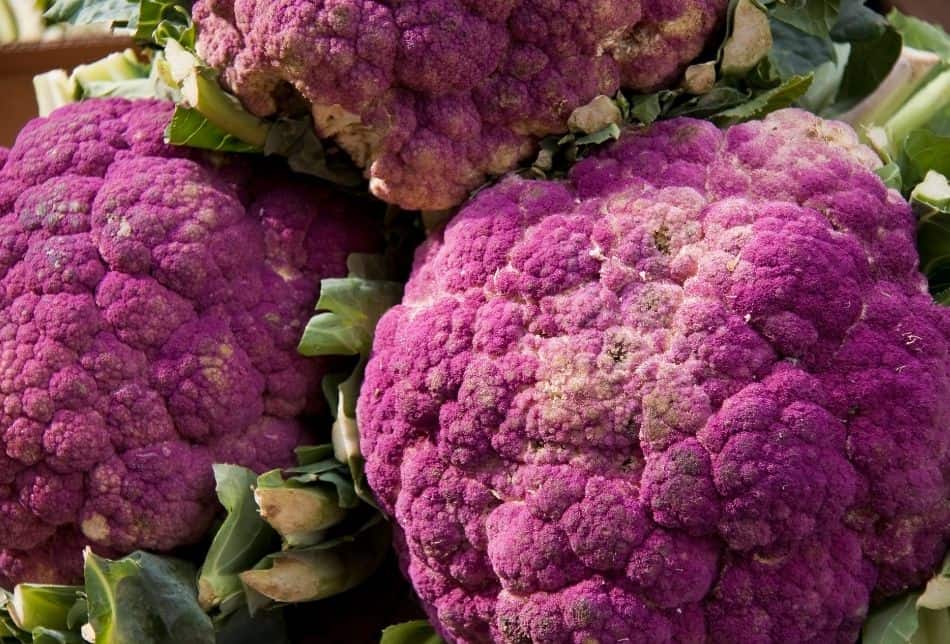
It has light to deep purple buds, green leaves, and a peppery, nutty flavor. Purple broccoli contains fiber, vitamins C & K, and selenium, potassium, and iron.
You can eat purple broccoli raw, steamed, or boiled. It tastes great in salads, soups, stir-fry, and gratins.
Fact: Broccoli was first cultivated in Northern Europe in the 18th century.
27. Purple Cabbage
Also known as red cabbage, this cruciferous vegetable is originally from the Mediterranean region of Europe.
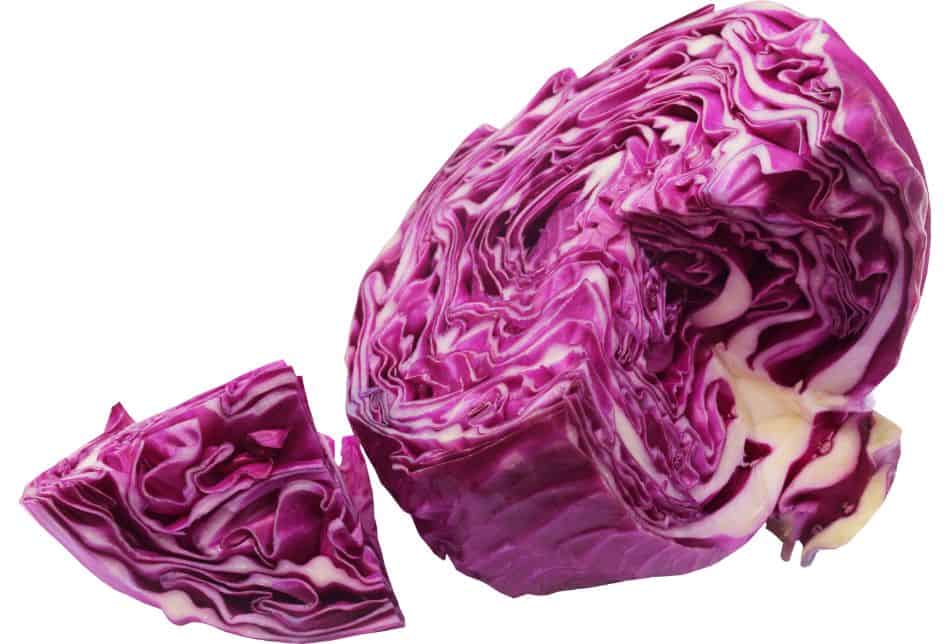
It has a deep purple color with white veins running through it. It is a good source of vitamins C and K. Plus, you can find calcium, zinc, and manganese.
Purple cabbage can be eaten raw or cooked. You can prepare salads, slaws, soups, stir-fries, and baked goods.
Interesting fact: Purple cabbage juice can be used as a natural food dye.
28. Purple Carrots
Purple Haze carrots are 5000 years old and hail from Iran or Afghanistan. They’re purple with an orange interior.
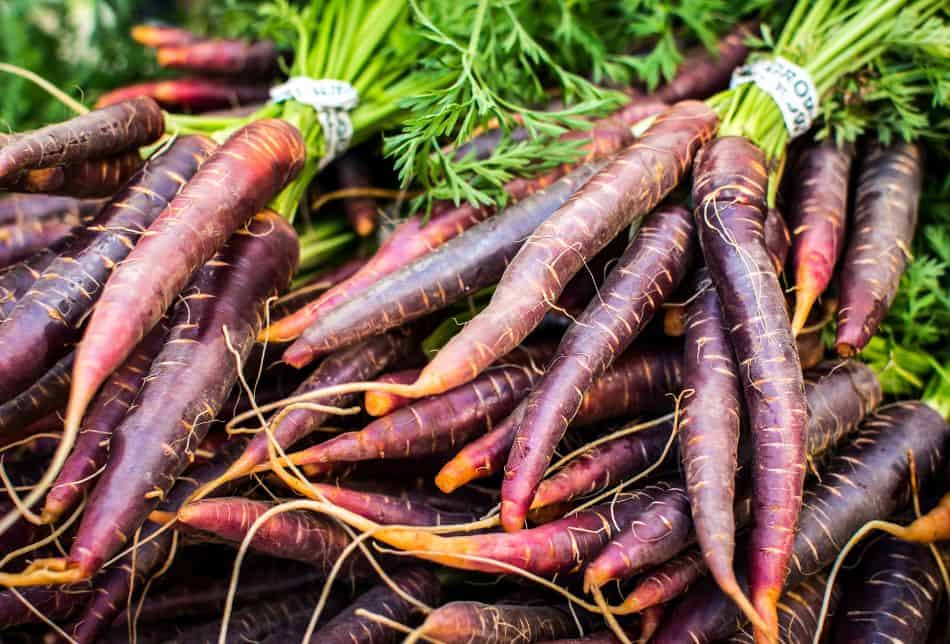
The purple carrot has an earthy, sweet flavor with undertones of celery and parsley. Some varieties may have a peppery taste.
Purple carrots are a good source of fiber, vitamin C, and minerals such as manganese, potassium, and fiber.
The best way to enjoy this fruit would be in salads or cole slaw; however, it loses its color when cooked.
Fact: Two more species of carrots are purple: Cosmic Purple (the same color as Purple Haze) and Black Nebula (dark purple color; retains it post-cooking).
29. Purple Carpet Creeping Thyme
Purple thyme is a type of herb native to North Africa and Europe.
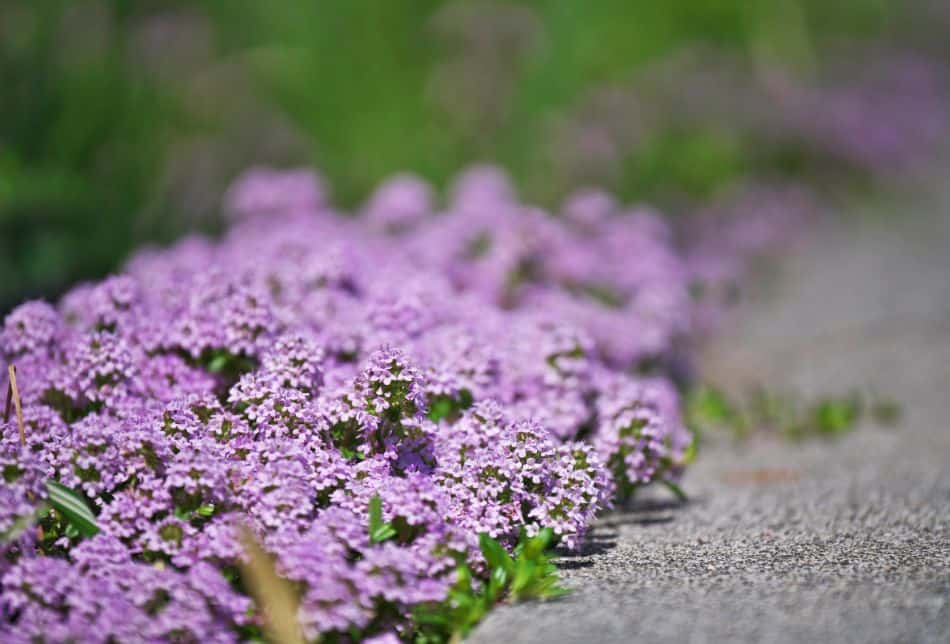
The flavor is strong, with notes similar to mint and lemon. It has dark green leaves with lavender purple flowers when in full bloom.
Purple thyme is a good source of vitamins C and K.
It contains manganese and iron. You can add purple thyme to soups, stews, or pasta dishes. You may also use it to flavor meat or vegetables.
30. Purple Cauliflower
Our next pick is from the Northeastern Mediterranean region.
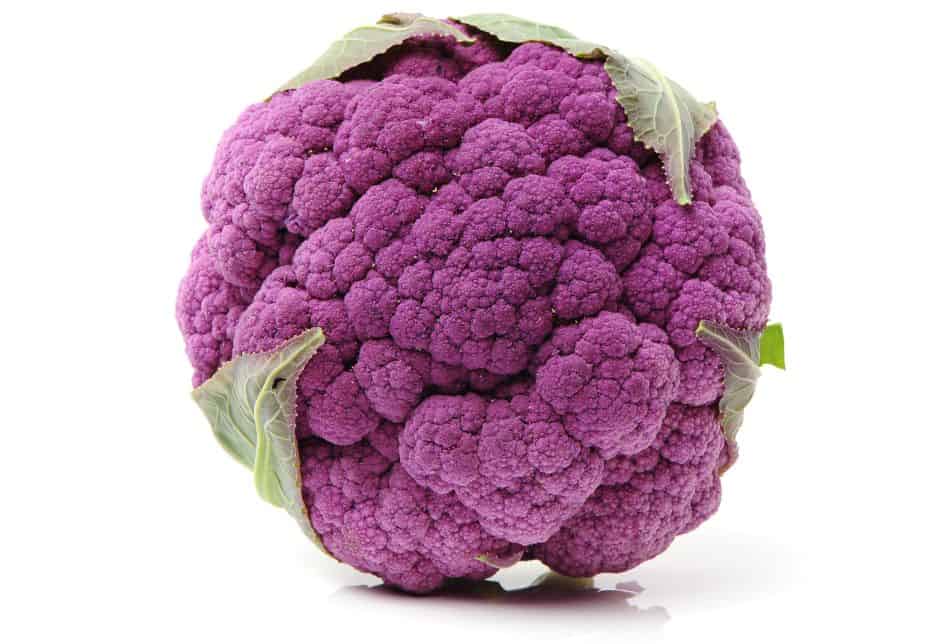
In 1849, Ephraim Wales Bull developed this mutation and named it after his home city-Concord, Massachusetts.
Lively and tender, the deep purple curds of this cauliflower have a milder flavor than their white counterparts. Bluish-green leaves surround them.
Just like its white counterpart, purple cauliflower can be eaten raw, roasted, grilled, or steamed. In addition, they combine well with other ingredients to make salads, rice dishes, pasta dishes, and soups.
Fact: There’s a type in Great Britain called purple cauliflower, which doesn’t fit any specific category because its leaves aren’t fully developed when green.
31. Purple Cayenne Pepper
This chili pepper comes from French Guiana and belongs to the capsicum family.
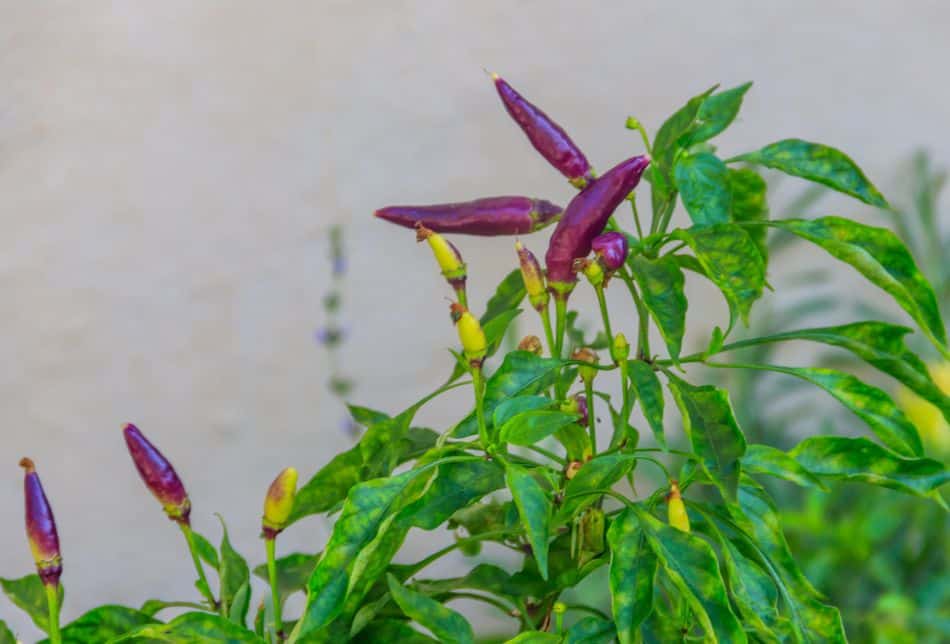
The 3 to 6-inch long dark purple pepper has white-purple flowers. It’s milder than red cayenne peppers but still has that signature fiery bite.
Cayenne peppers are a good source of vitamins A and C and minerals like potassium and magnesium.
32. Purple Chokeberries
The chokeberry is a type of fruit native to North America.
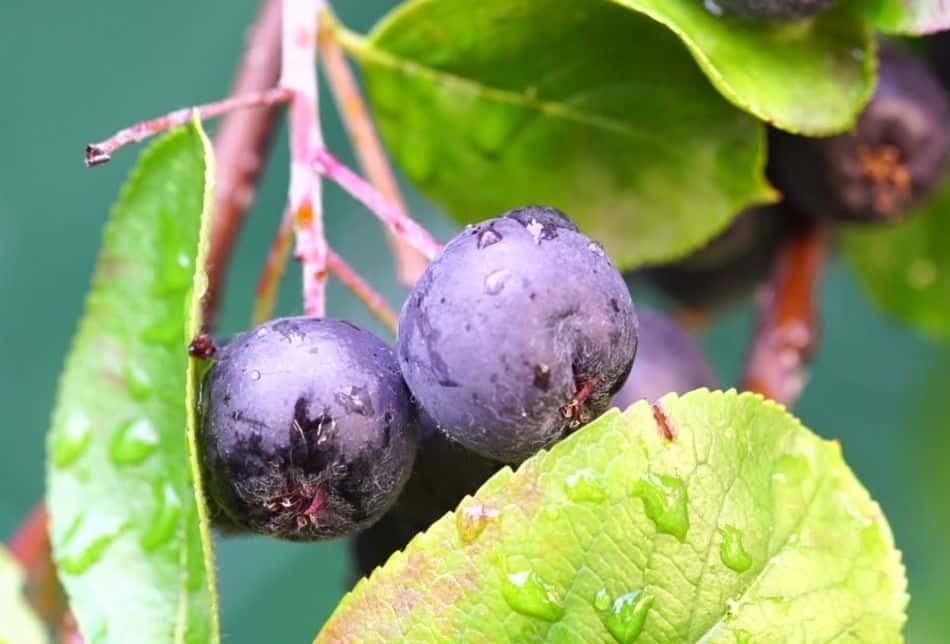
The small, round, and purple-colored jewels have an astringent flavor with hints of sweetness beneath their tartness.
They contain fiber, vitamins A & C, and other essential nutrients like manganese or iron. Eat them on their own (or any other tasty fruit) as an afternoon snack.
Fact: The chokeberry is sometimes called the “Aronia berry”
33. Purple Corn
Purple corn is a variety of corn that has deep purple kernels.
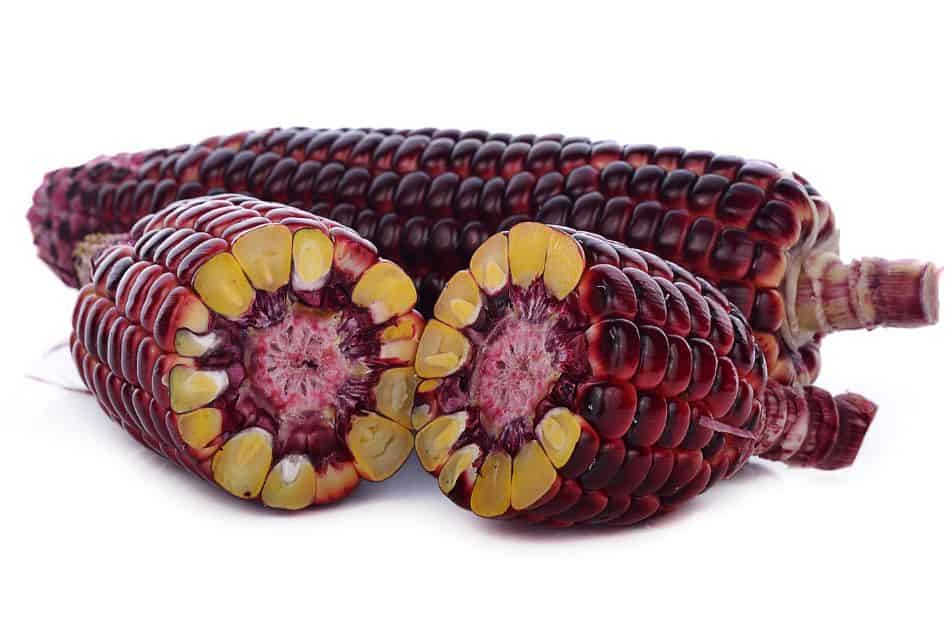
Purple corn is a good source of fiber, vitamins C and E, and magnesium. The sweet nutty flavor combined with the crisp texture makes it a perfect food.
You can eat purple corn raw, roasted, grilled, or boiled. It’s also a great addition for salads, soups, stews, and gratins.
Fact: Purple corn is native to South America and was first cultivated by the Incas.
34. Purple Pod Pole Beans
Purple pod pole beans are a type of edible green from Peru.
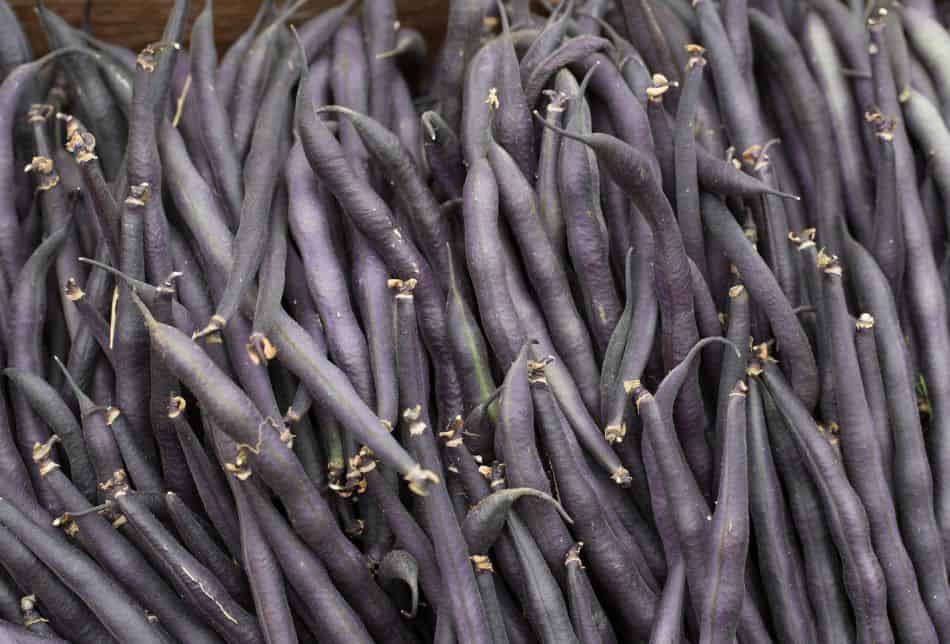
These greens have a deep purple color and a sweet taste.
They’re also an excellent source of vitamins A and C. You can enjoy these fruits raw or cooked, depending on your preference.
They make great additions to soups, casseroles, and salad bars alike.
Fact: Purple pod pole greens are sometimes called “Chinese amaranth.”
35. Purple Potatoes
Purple potatoes are native to the Andes region of South America and have been grown there for centuries.
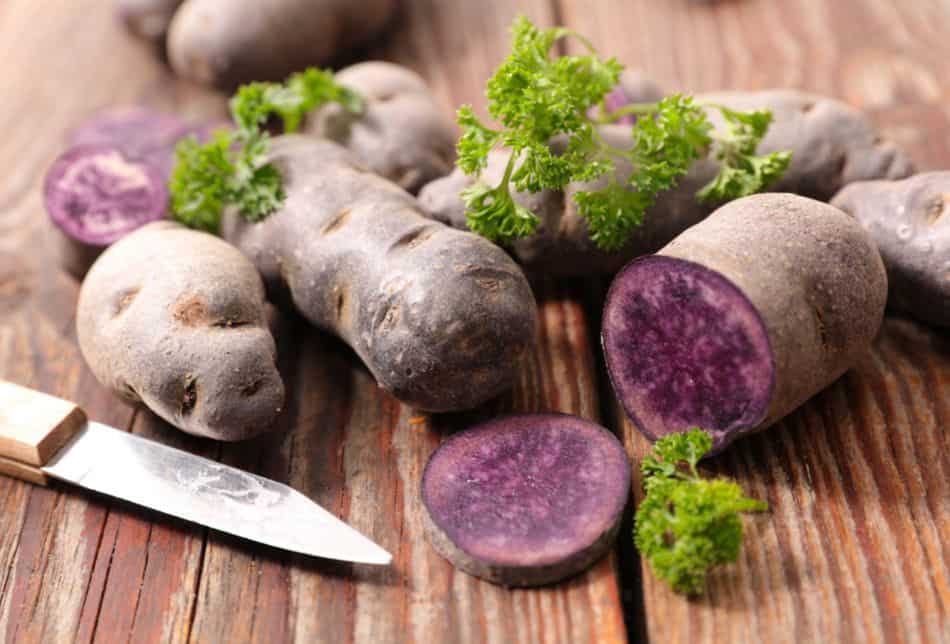
The potato has a deep purple color with purple flesh that provides a nutty and earthy flavor. They contain fiber, vitamins C and B6, and minerals such as manganese and potassium.
You can eat purple potatoes raw, roasted, baked, or mashed.
They can be mixed into salads, soups, stews, and gratins to make them taste better.
Fact: The purple potato is sometimes called the “Peruvian potato.”
36. Purple Sweet Potatoes
Sweet potatoes come in many different colors, including purple. The purple sweet potato was first developed in Louisiana.
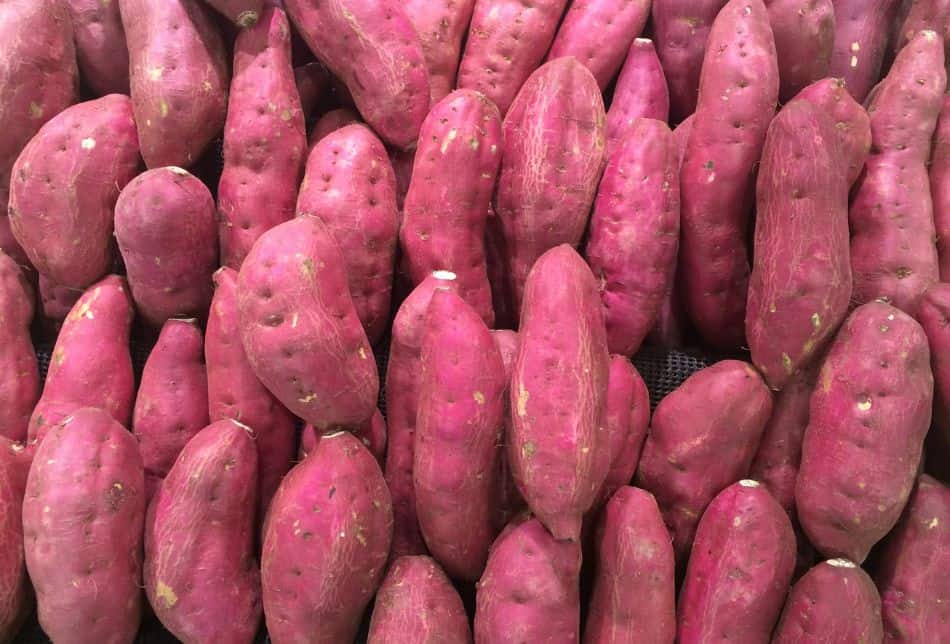
It is a variety of sweet potato with reddish-purple skin and white flesh. They are a combination of nutty sweetness and a hint of vanilla flavor.
Purple sweet potatoes are a good source of fiber, vitamins C and A, and potassium. You can eat purple sweet potatoes roasted, or as a puree.
They make a great mix for soups, stews, and gratins. You can also use them to make chips or fries.
37. Purple Vienna Kohlrabi
Kohlrabi is a member of the brassica family, which includes broccoli, cabbage, and cauliflower, and is natively from Northern Europe.
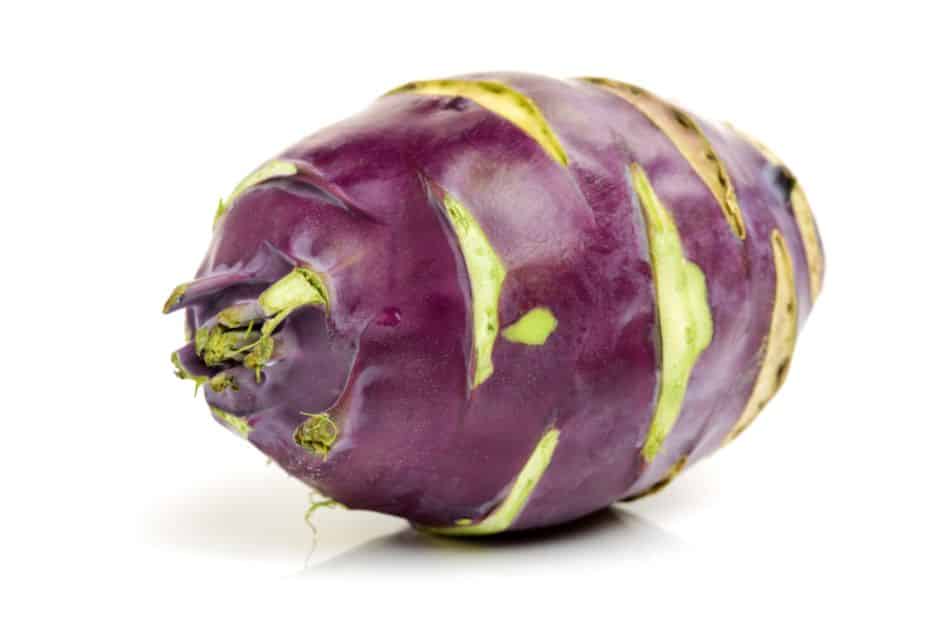
The kohlrabi has a deep purple color with white flesh similar to cabbage or broccoli stems but has a mild flavor.
Purple kohlrabi is a good source of fiber, vitamins C and B6, and minerals such as fiber and potassium.
You can eat them raw, roasted, baked, or mashed. They make a great ingredient in salads, soups, riced, and pureed.
Fact: The word “kohlrabi” comes from the German words for cabbage (kohl) and turnip (rabi).
38. Purple Yam
Purple yam is a type of sweet potato originally from Southeast Asia.
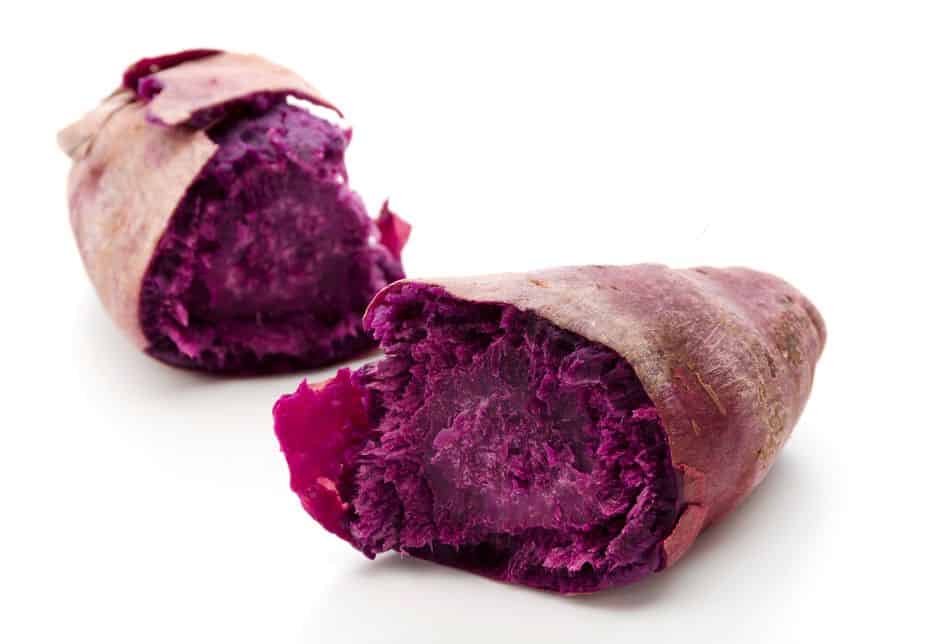
The yam has deep reddish-purple skin and white flesh with a sweet, nutty flavor. Purple yams are a good source of fiber, vitamins C and B6, and potassium.
You can eat them raw, but they’re also great when cooked, mashed, or roasted for an even richer flavor. They work well in soups, stews, and gratins as well.
Fact: The purple yam is also known as the “Japanese yam”, “Water yam”, and “Ube sweet potato.”
39. Purple Wheat
Wheat is a grain used to make bread, pasta, cereal, and many other foods.
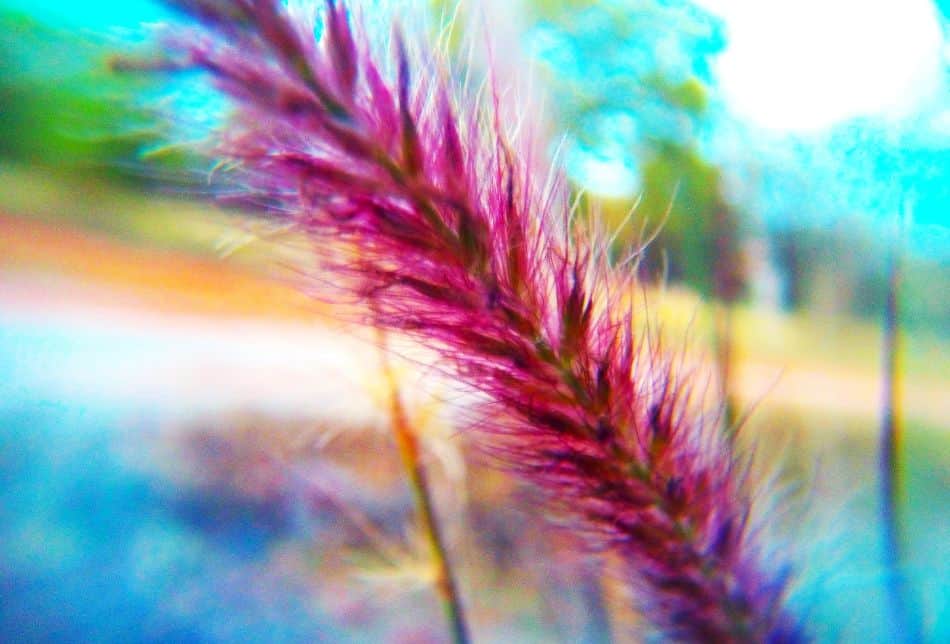
This variety of wheat has a deep purple color and an earthy flavor. It’s native to highlands in Ethiopia but can now be found across continents.
Purple wheat is a good source of fiber, and vitamins B1, B3, and E. Plus, it contains manganese, magnesium, phosphorus, and iron.
Try purple wheat in bread, pasta, cereals, or as a healthy snack. You can also use it to add color and flavor to salads and soups.
Fact: Wheat is one of the oldest crops in the world. Humans first cultivated it over 10,000 years ago.
40. Radicchio
Radicchio is natively from Italy. It has a deep red or purple color with white veins running through it.
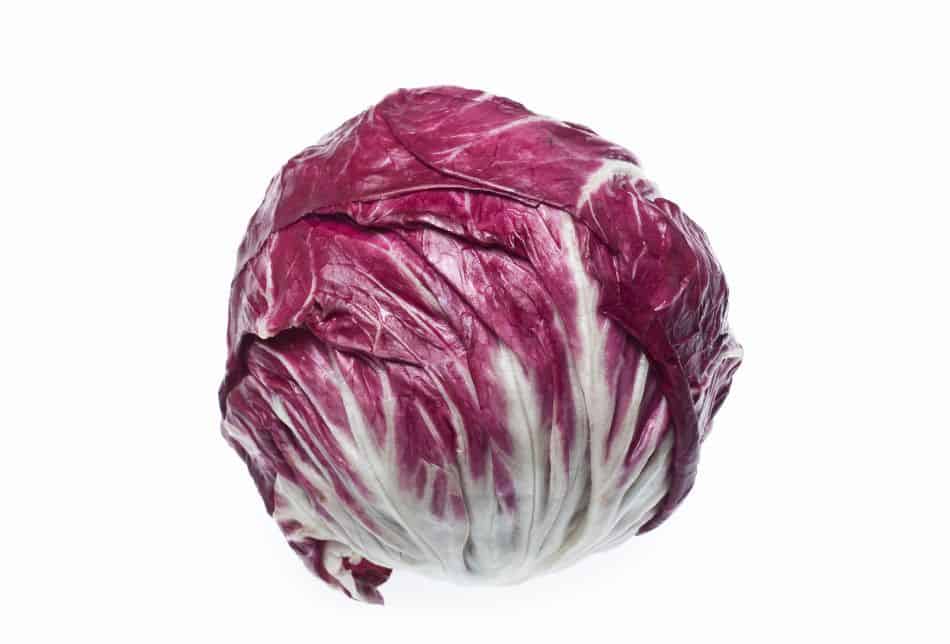
Radicchio’s slightly bitter with a peppery flavor provides fiber, vitamins C and K, and minerals such as potassium and manganese.
You can eat radicchio raw or cooked. It can be used in salads, slaws, soups, pasta dishes, and risotto.
Fact: “R” comes from the Italian word for “root” because the vegetable was traditionally grown in root cellars.
41. Raisins
Raisins are dried grapes. They can be made from various grape types, and different grapes create different flavors and textures in the raisins.
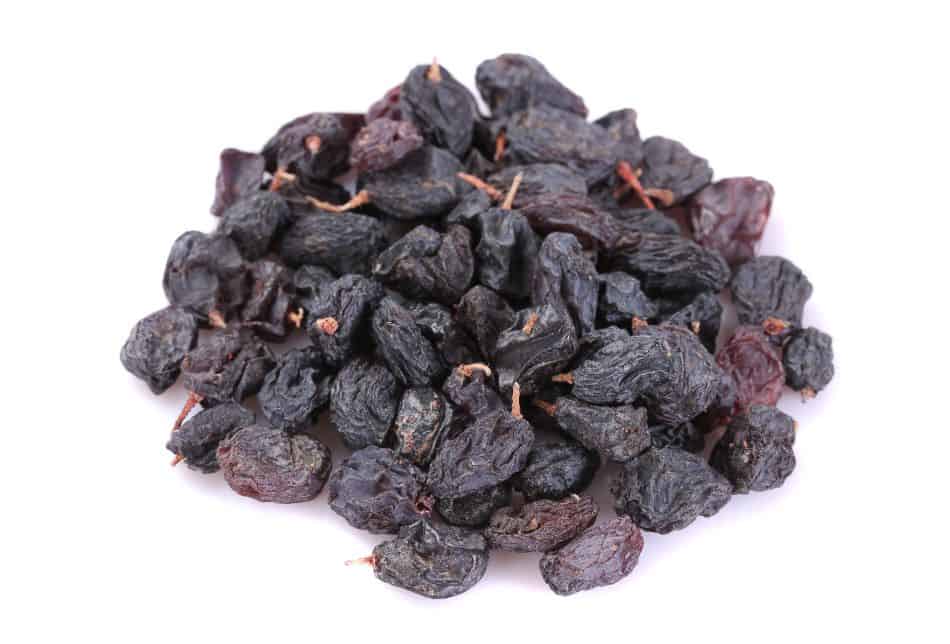
Raisins are a good source of vitamins C and K in addition to containing iron, potassium, and magnesium.
Raisins are versatile and can be used in many dishes, from cereal and oatmeal to granola and yogurt.
They’re also great for adding sweetness to your favorite bars or cookies.
The earliest known mention of raisin grapes came from 2000 BCE, when they were grown in Persia and Egypt.
42. Red Dragon Fruit
The Red Dragon fruit is a medium-sized, oval, oblong-shaped citrus variety with small leaves and many venomous spikes. It is native to Central America and Southern Mexico.
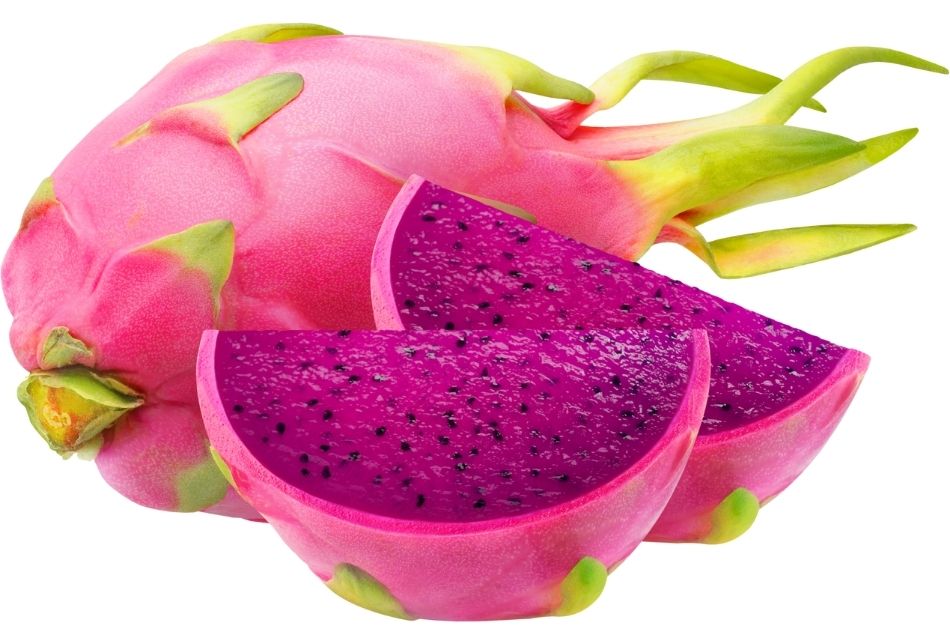
The dark red flesh of this dragon fruit gradually turns into a purplish color as it ripens.
It has an intense, sweet flavor, and combined with kiwi or pear, you’ll enjoy its mild taste while feeling satisfied by all the vitamins C, B2, and niacin.
The red dragon fruit is a delicious and versatile ingredient.
You can eat it raw, grill or add this superfood to cocktails for an extra boost in nutrients or make salads.
Fact: The red dragon fruit is also known as the “strawberry pear.”
43. Red Leaf Lettuce
Red leaf lettuce, sometimes called “Purple Leaf Lettuce” is from Europe. It is a lettuce variety with light to deep purple leaves with red veins.
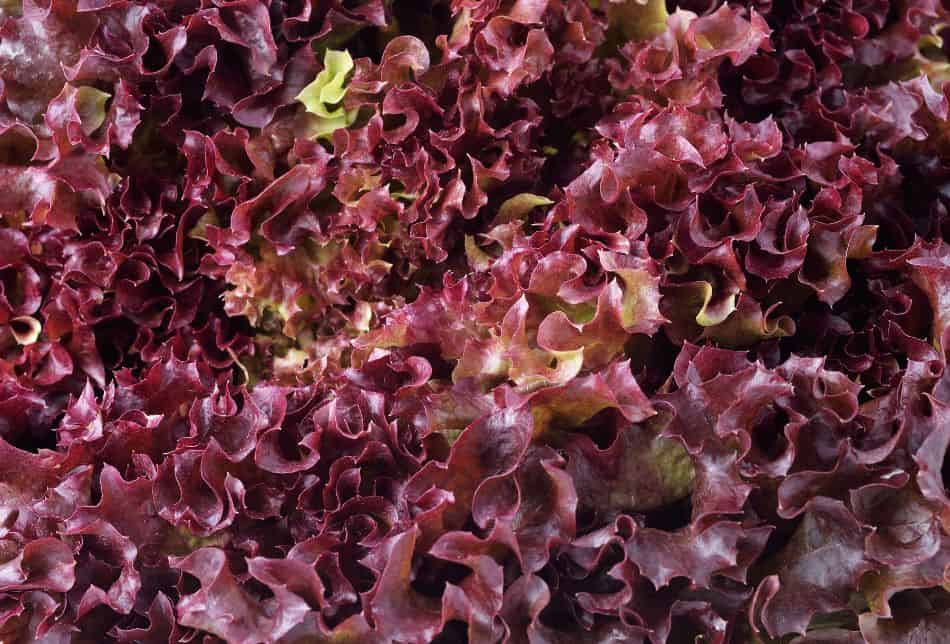
It has the perfect combination of sweet and peppery flavors. This healthy green veggie also contains Vitamins C & folate and calcium or iron.
You can eat raw red leaf lettuce in salads, boiling, braising, or in gratins. You can also use it to prepare wraps and sandwiches.
Fact: Red lettuce can grow as tall as 30 cm.
44. Red Onions
Red onions are originally from Tropea in Italy. Red onions are of a purple-red color, with white flesh and a hint of red.
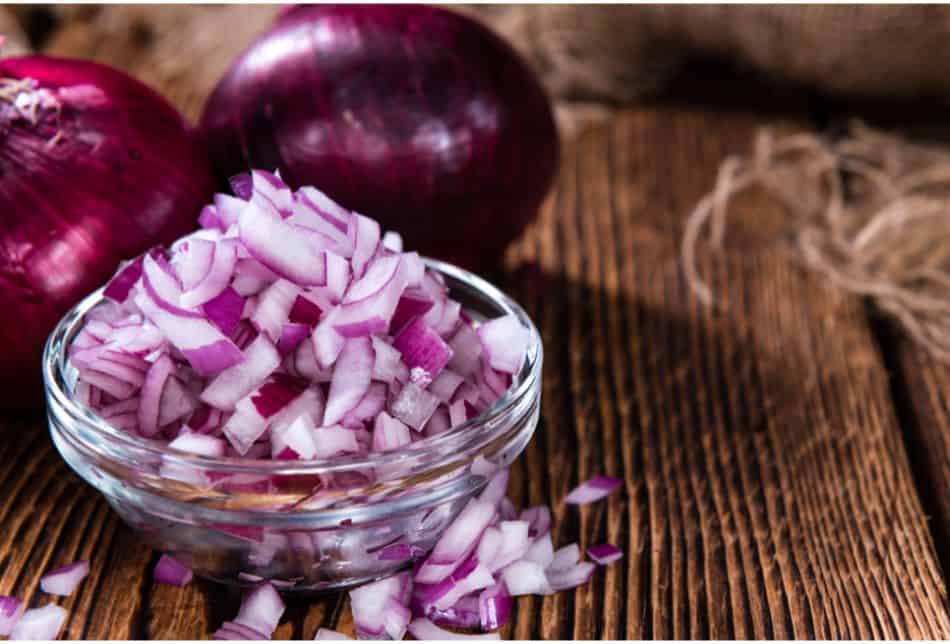
Red onions are a good source of fiber, vitamins C and B6, and manganese. You can enjoy the sweet and spicy flavor of red onions in raw or cooked form.
They make a great addition to salads and toppings, or you can also use them to make onion rings or chips.
Fact: The skin of red onions can be used as a dye.
45. Star Apple
The star apple is a type of fruit that is native to tropical Southeast Asia. It is a deep purple fruit with the shape of stars on its seeds.
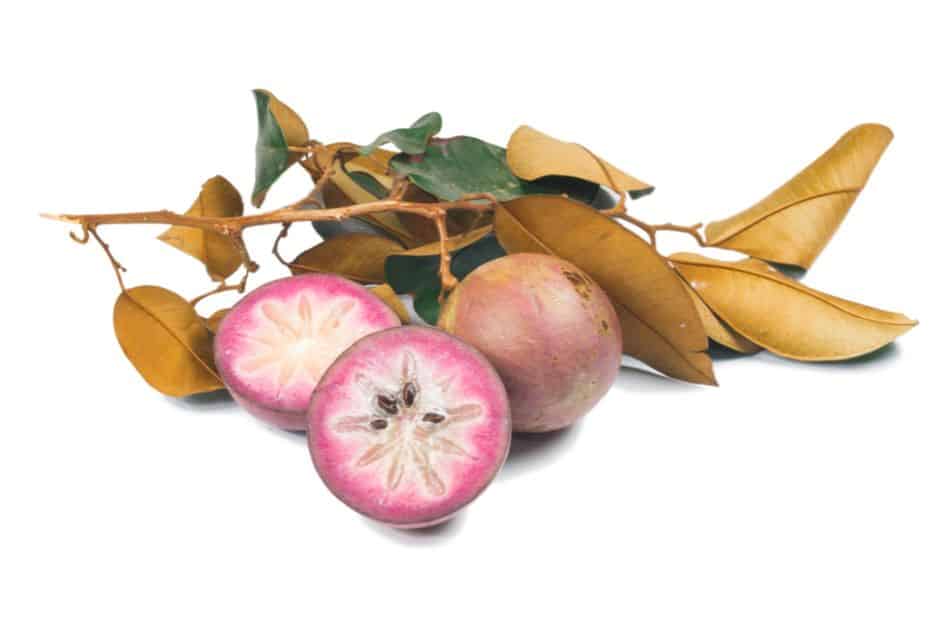
The pulpy, jelly-like texture and sweet-sour taste are a good source of vitamins C and B6 and minerals such as potassium, sodium, and other antioxidants.
Star apples are not just for eating raw. You can also use them in salads, desserts, and smoothies. They’re great as fruit compote or jammy sauces too.
Fact: The star apple is also known as the “caimito.”
46. Violets
Violets are a spice that has been enjoyed for centuries. Native to Asia and Europe, these flowers can be eaten raw or cooked in dishes. They can also be used to make violet tea.
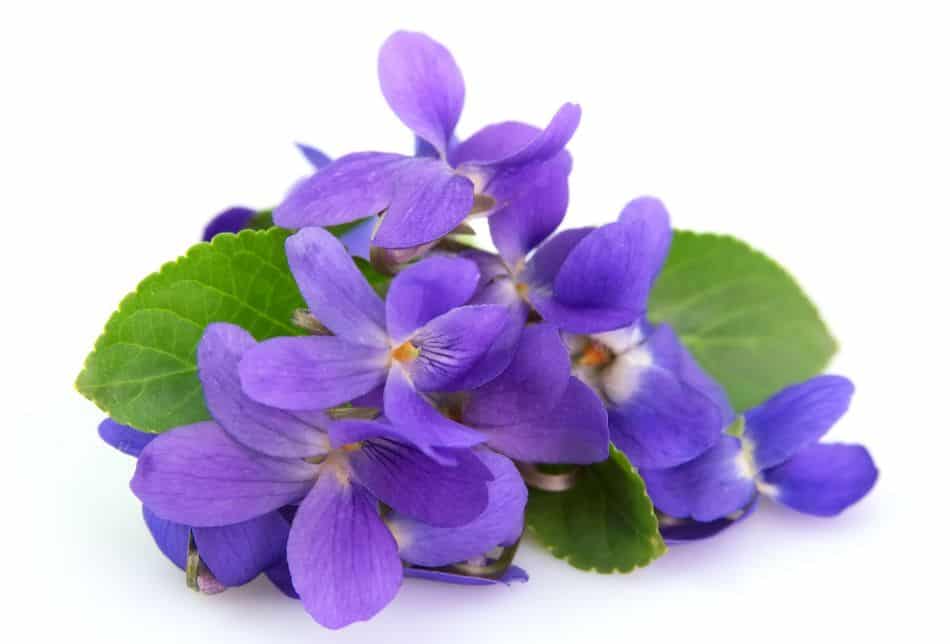
Violets are an excellent source of vitamins A and C. They also contain flavonoids, and antioxidants that can help protect the body from damage.
Fact: The violet is the national flower of Slovenia and Greece. It is also the state flower of Illinois, Rhode Island, and New Jersey.
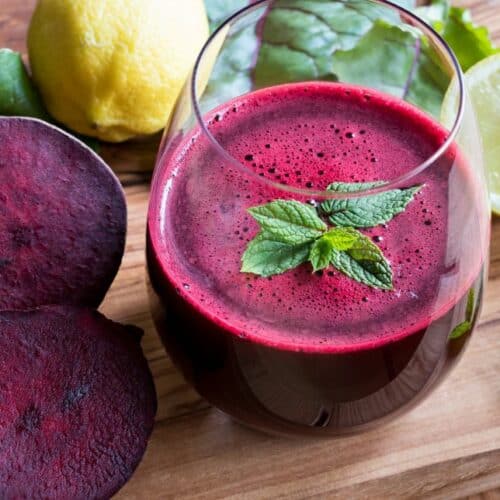
Foods That Are Purple In Color
Ingredients
- Acai Berries
- Baby Purple Artichokes
- Beetroot
- Beet Greens
- Beet Juice
- Cherries (Chelan Cherry)
- Concord Grapes
- Concord Grape Juice
- Eggplant
- Elderberries
- Figs
- Forbidden Rice
- Kale
- Lavender
- Mangosteen
- Passion Fruit
- Plums (Damsons Plum)
- Pluots (Dapple Dandy Pluot)
- Pomegranates
- Prunes
- Purple Asparagus
- Purple Barley
- Purple Basil
- Purple Belgian Endive
- Purple Bell Pepper
- Purple Broccoli
- Purple Cabbage
- Purple Carrots
- Purple Carpet Creeping Thyme
- Purple Cauliflower
- Purple Cayenne Pepper
- Purple Chokeberries
- Purple Corn
- Purple Pod Pole Beans
- Purple Potatoes
- Purple Sweet Potatoes
- Purple Vienna Kohlrabi
- Purple Yam
- Purple Wheat
- Radicchio
- Raisins
- Red Dragon Fruit
- Red Leaf Lettuce
- Red Onions
- Star Apple
- Violets

